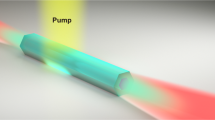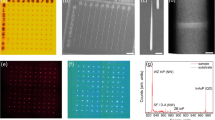Abstract
Electrically driven semiconductor lasers are used in technologies ranging from telecommunications and information storage to medical diagnostics and therapeutics1. The success of this class of lasers is due in part to well-developed planar semiconductor growth and processing, which enables reproducible fabrication of integrated, electrically driven devices2,3. Yet this approach to device fabrication is also costly and difficult to integrate directly with other technologies such as silicon microelectronics. To overcome these issues for future applications, there has been considerable interest in using organic molecules4,5, polymers6,7, and inorganic nanostructures8,9,10 for lasers, because these materials can be fashioned into devices by chemical processing. Indeed, amplified stimulated emission and lasing have been reported for optically pumped organic systems4,5,6,7 and, more recently, inorganic nanocrystals8,9 and nanowires10. However, electrically driven lasing, which is required in most applications, has met with several difficulties in organic systems11, and has not been addressed for assembled nanocrystals or nanowires. Here we investigate the feasibility of achieving electrically driven lasing from individual nanowires. Optical and electrical measurements made on single-crystal cadmium sulphide nanowires show that these structures can function as Fabry–Perot optical cavities with mode spacing inversely related to the nanowire length. Investigations of optical and electrical pumping further indicate a threshold for lasing as characterized by optical modes with instrument-limited linewidths. Electrically driven nanowire lasers, which might be assembled in arrays capable of emitting a wide range of colours, could improve existing applications and suggest new opportunities.
This is a preview of subscription content, access via your institution
Access options
Subscribe to this journal
Receive 51 print issues and online access
$199.00 per year
only $3.90 per issue
Buy this article
- Purchase on Springer Link
- Instant access to full article PDF
Prices may be subject to local taxes which are calculated during checkout



Similar content being viewed by others
References
Gray, G. R. in Semiconductor Laser: Past, Present, and Future (ed. Agrawal, G. P.) 284–320 (American Institute of Physics, New York, 1995)
Kapon, E. (ed.) Semiconductor Lasers I: Fundamentals (Academic, San Diego, 1999)
Kapon, E. (ed.) Semiconductor Lasers II: Materials and Structures (Academic, San Diego, 1999)
Kozlov, V. G., Bulovic, V., Burrows, P. E. & Forrest, S. R. Laser action in organic semiconductor waveguide and double-heterostructure devices. Nature 389, 362–363 (1997)
Bergren, M., Dodabalapur, A., Slusher, R. E. & Bao, Z. Light amplification on organic thin films using cascade energy transfer. Nature 389, 466–469 (1997)
Tessler, N., Denton, G. J. & Friend, R. H. Lasing from conjugated-polymer microcavities. Nature 382, 695–697 (1996)
Hide, F. et al. Semiconductor polymers: A new class of solid state laser materials. Science 273, 1833–1836 (1996)
Klimov, V. I. et al. Optical gain and stimulated emission in nanocrystal quantum dots. Science 290, 314–317 (2000)
Kazes, M., Lewis, D. Y., Ebenstein, Y., Mokari, T. & Banin, U. Lasing from semiconductor quantum rods in a cylindrical microcavity. Adv. Mater. 14, 317–321 (2002)
Huang, H. M. et al. Room-temperature ultraviolet nanowire nanolasers. Science 292, 1897–1899 (2001)
Kozlov, V. G. et al. Structures for organic laser diode lasers and optical properties of organic semiconductor under intense optical and electrical excitations. IEEE J. Quant. Elec. 36, 18–26 (2000)
Morales, A. M. & Lieber, C. M. A laser ablation method for the synthesis of crystalline semiconductor nanowires. Science 279, 208–211 (1998)
Duan, X. & Lieber, C. M. General synthesis of compound semiconductor nanowires. Adv. Mater. 12, 298–302 (2000)
Gudiksen, M. S. & Lieber, C. M. Diameter selective synthesis of semiconductor nanowires. J. Am. Chem. Soc. 122, 8801–8802 (2000)
Duan, X., Huang, Y., Wang, J., Cui, Y. & Lieber, C. M. Indium phosphide nanowires as building blocks for nanoscale electronic and optoelectronic devices. Nature 409, 66–69 (2001)
Cui, Y. & Lieber, C. M. Functional nanoscale electronic devices assembled using silicon nanowire building blocks. Science 291, 891–893 (2001)
Huang, Y. et al. Logic gates and computation from assembled nanowire building blocks. Science 294, 1313–1317 (2001)
Chen, C.-L. Elements of Optoelectronics and Fiber Optics (Irwin, Chicago, 1996)
Wang, J., Gudiksen, M. S., Duan, X., Cui, Y. & Lieber, C. M. Highly polarized photoluminescence and polarization sensitive photodetectors from single indium phosphide nanowires. Science 293, 1455–1457 (2001)
Bagnall, D. M., Ullrich, B., Sakai, H. & Segawa, Y. Micro-cavity lasing of optically excited CdS thin films at room temperature. J. Cryst. Growth. 214/215, 1015–1018 (2000)
Bagnell, D. M., Ullrich, B., Qiu, X. G., Segawa, Y. & Sakai, H. Microcavity lasing of optically excited cadmium sulphide thin films at room temperature. Opt. Lett. 24, 1278–1280 (1999)
Huang, Y., Duan, X., Cui, Y. & Lieber, C. M. GaN nanowire nanodevices. Nano Lett. 2, 101–104 (2002)
Gudiksen, G. S., Lauhon, L. J., Wang, J., Smith, D. & Lieber, C. M. Growth of nanowire superlattice structures for nanoscale photonics and electronics. Nature 415, 617–620 (2002)
Lauhon, L. J., Gudiksen, M. S., Wang, D. & Lieber, C. M. Epitaxial core-shell and core-multishell nanowire heterostructures. Nature 420, 57–61 (2002)
El Assali, K. et al. Some structural and optical properties of CdS thin films prepared by RF sputtering. Phys. Status Solidi A 178, 701–708 (2000)
Acknowledgements
We thank H. Park, X. Zhuang & M. S. Gudiksen for helpful discussion. C.M.L. is grateful for support of this work by the Air Force Office of Scientific Research.
Author information
Authors and Affiliations
Corresponding author
Ethics declarations
Competing interests
The authors declare that they have no competing financial interests.
Supplementary information
Rights and permissions
About this article
Cite this article
Duan, X., Huang, Y., Agarwal, R. et al. Single-nanowire electrically driven lasers. Nature 421, 241–245 (2003). https://doi.org/10.1038/nature01353
Received:
Accepted:
Issue Date:
DOI: https://doi.org/10.1038/nature01353
This article is cited by
-
Investigation on electrical, structural, magnetic, optical properties and EPR studies of CdCu2O3 composite oxide prepared via sol–gel method
Indian Journal of Physics (2024)
-
Short-wave infrared cavity resonances in a single GeSn nanowire
Nature Communications (2023)
-
Electrically driven single microwire-based single-mode microlaser
Light: Science & Applications (2022)
-
Self-frequency-conversion nanowire lasers
Light: Science & Applications (2022)
-
Phosphide in gallium bismuth: structural, electronic, elastic, and optical properties of GaPxBi1−x alloys
Journal of Molecular Modeling (2022)
Comments
By submitting a comment you agree to abide by our Terms and Community Guidelines. If you find something abusive or that does not comply with our terms or guidelines please flag it as inappropriate.



